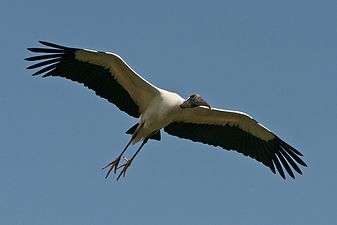St. Vincent National Wildlife Refuge
| St. Vincent National Wildlife Refuge | |
|---|---|
|
IUCN category V (protected landscape/seascape) | |
|
Endangered red wolf | |
 | |
| Location | Franklin and Gulf counties, Florida, United States |
| Nearest city | Apalachicola, Florida |
| Coordinates | 29°38′40″N 85°07′47″W / 29.64435°N 85.1298°WCoordinates: 29°38′40″N 85°07′47″W / 29.64435°N 85.1298°W |
| Area | 12,490 acres (51 km2) |
| Established | 1968 |
| Governing body | US Fish & Wildlife Service |
| Website | St. Vincent National Wildlife Refuge |
The St. Vincent National Wildlife Refuge is part of the United States National Wildlife Refuge System, located in northwestern Florida, on the barrier island of St. Vincent, off the coast of Apalachicola.
The 12,490 acre (51 km2) refuge was established in 1968.
St. Vincent National Wildlife Refuge occupies a barrier island in the Gulf of Mexico. Little more than a quarter mile out in the Gulf, the refuge is a short distance from the mainland. Because access is limited to boat traffic, the refuge rarely sees large concentrations of people. Visitors can enjoy long solitary walks on the beaches or venture into the interior of the island and explore the ten habitat types located here. Very limited development of the island (primarily during a time when it was privately owned) has left it virtually pristine. The earliest documented visitors to the island dates to the year 240 (from pottery shards) when Native Americans lived on the island. St. Vincent Island has had a very colorful past through numerous owners and, in 1948, was even stocked with imported zebra, eland, black buck, ring-necked pheasant, Asian junglefowl, bobwhite quail and turkey. The island was purchased by The Nature Conservancy in 1968 for $2.2 million and U.S. Fish and Wildlife repaid them with proceeds from Duck Stamp sales and the St. Vincent National Wildlife Refuge was established.
Depending on the season, many species can be observed with a number of them being endangered and threatened. Springtime reveals nesting and reproductive behavior in many animals seen on the island such as osprey, softshell turtle and wood duck. In addition, white-tailed deer bucks shed their antlers and young bald eagles are taking flight. Summer brings loggerhead sea turtles to lay eggs on the beach and alligator females on nests in the marshes. Many bird species can be seen including wood stork, snowy plover and American oystercatcher. Fall brings migration and the refuge is inundated with waterfowl, shorebirds and songbirds. Peregrine falcons have been spotted during this time. White-tailed deer are readying for the rut which happens in the winter season. Also in winter, waterfowl numbers are at their highest and bald eagles and great horned owls are nesting. Alligators, other reptiles and many other animal species are found year-round on the island. Since 1990, St. Vincent National Wildlife Refuge has been one of several coastal islands in the southeast where endangered red wolves are being bred. The wolves are allowed to roam the island and the pups raised here are taken (after weaning) to Alligator River National Wildlife Refuge in North Carolina.
As it is an island environment limited in size, visitors are asked to be very cognizant of wildlife and behavior. Visitors should leave no trace on the island, other than footprints.
Access
The closest public boat ramp to the island is located 22 miles west of Apalachicola at the end of County Road 30-B. From that boat ramp it is one-quarter of a mile across to the island. Boaters should be sensitive to winds, tide fluctuations, currents, storms, and oyster bars. Private shuttle service to the island is operated by St. Vincent Island and Fishing Charters.
|
References
External links
-
 Media related to St. Vincent National Wildlife Refuge at Wikimedia Commons
Media related to St. Vincent National Wildlife Refuge at Wikimedia Commons - St. Vincent National Wildlife Refuge at U.S. Fish and Wildlife Service
- St. Vincent National Wildlife Refuge at Gorp.com






